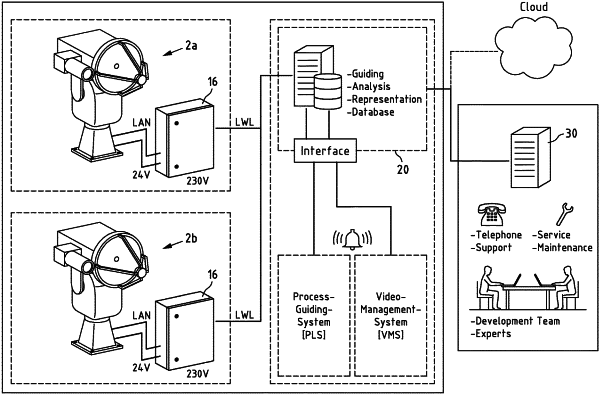| CPC G01N 21/3504 (2013.01) [G01N 33/0027 (2013.01); G01N 2021/3595 (2013.01); G06Q 50/265 (2013.01)] | 12 Claims |

|
1. A system for monitoring an airspace of an area,
with at least two optical sensors with a passive Fourier transform infrared spectrometer and
with a server for evaluating the measurement data and for controlling the at least two optical sensors,
wherein each optical sensor has an adjustable monitoring range and wherein the monitoring ranges of the at least two optical sensors overlapping at least in sections, and
wherein the server is set up,
to control the optical sensors in the normal case for an automatic scanning of the monitored areas, wherein the server assigns to the measurement data in each case a solid angle on the basis of the position data of the optical sensor,
deriving the spectral intensity distribution of the received IR radiation from the measurement data of the optical sensors for each solid angle and identifying at least one target substance by means of correlation of the intensity distribution with known gas spectra,
in case of an incident, when a first optical sensor identifies a target substance in a first solid angle, to control at least one further optical sensor to scan the overlapping area with the monitoring area of the first optical sensor,
identifying from the measurement data of the at least one further optical sensor at least one further solid angle with an infrared signal of the target substance, and
determining the coordinates of the overlap area with increased concentration of the target substance from the solid angle information of the first solid angle and the at least one further solid angle,
wherein the monitoring range of each optical sensor has different measuring radii due to the topography and/or the development of the area as a result of shadowing depending on the solid angle, and the monitoring range of each optical sensor is defined by the solid angle range and the associated measuring radii,
that the measuring radii per solid angle are determined and set during the installation of the system for the optical sensors based on the known topography and/or development of the area and
wherein the measurement signals of the at least one further optical sensor in spatial directions with too small a measurement radius are not included in the evaluation.
|